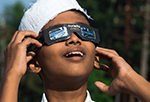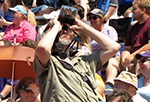
The anticipation for the 2024 total solar eclipse, is growing among astronomy enthusiasts worldwide. Set for April 8, 2024. This astronomical marvel presents a rare opportunity, to observe the moon completely obscuring the sun. To fully enjoy this inspiring event, thorough preparation is essential. This article offers 10 important tips, to help you plan your journey to witness the eclipse. Helping to ensure a memorable and safe experience.
From selecting an ideal location, to understanding the eclipse’s timing. Each tip is designed, to enhance your encounter with this celestial spectacle. Prepare to be captivated by the dance of celestial bodies, in a display that is truly a wonder to behold.
Key Takeaways
- Get ahead of the game for the eclipse by; picking prime spots, booking travel and accommodations well in advance. Plus, keeping an eye on the weather & crowds.
- Prioritize finding protective eyewear for the solar spectacle. Ensure you have the right ISO-certified glasses & steer clear of unsuitable alternatives.
- Dive into the local scene and online groups, for a richer eclipse adventure. Additionally, soak up tips and tales from those who’ve witnessed it before.
Tip 1: Plan Ahead
Planning for the 2024 total solar eclipse. Is not something you can do at the last minute, if you want the best experience. Prime viewing locations, especially in cities that fall directly in the path of totality, will be in high demand. Flights to these destinations will fill up fast, and accommodations will become scarce and expensive as the date approaches. Start by researching the best spots to witness the eclipse, taking into consideration factors like weather patterns and crowd density.
Once you’ve chosen your ideal location, make your flight and accommodation bookings as early as possible. Early planning will not only secure your spot but also give you the luxury of choosing from the best options. Additionally, it will provide you with ample time to sort out other logistics such as; local transportation, meals and any special equipment you might need for viewing or capturing the eclipse. (1)
Tip 2: Choose the Right Location
 Choosing the right location is paramount for an optimal viewing experience. Cities like Austin, San Antonio, and Dallas in Texas. Or, cities such as West Plains, Missouri and Paducah, Kentucky. Are not only in the path of totality but also offer various vantage points for viewers. These cities are planning special events and viewing areas, to accommodate the influx of eclipse enthusiasts. If you’re considering international options, parts of Mexico and Canada will also fall within the eclipse’s path, offering unique viewing experiences.
Choosing the right location is paramount for an optimal viewing experience. Cities like Austin, San Antonio, and Dallas in Texas. Or, cities such as West Plains, Missouri and Paducah, Kentucky. Are not only in the path of totality but also offer various vantage points for viewers. These cities are planning special events and viewing areas, to accommodate the influx of eclipse enthusiasts. If you’re considering international options, parts of Mexico and Canada will also fall within the eclipse’s path, offering unique viewing experiences.
When selecting a location, it’s crucial to consider the sky’s visibility. An ideal spot would be an open field, a hill, or a rooftop with an unobstructed view of the sky. This ensures that buildings, trees, or other potential obstructions won’t hinder your experience. Early scouting of your chosen location can provide valuable insights into the best spots for viewing.
Tip 3: Understand the Timing
Timing is a critical factor, that can significantly influence your viewing experience. If viewing from the USA. Most will witness totality beginning in Texas, around 1:27 pm CDT. It will then make its way through to Maine, and complete sometime around 3:35 pm EDT. The exact timing will vary depending on your time zone / geographical location. Knowing the precise time the eclipse will start, reach totality and end. Can help you plan your day meticulously. This is especially important because the totality phase. Where the moon completely covers the sun, lasts for only a few minutes. Missing it, would mean missing the most awe-inspiring part of the event.
Various apps and websites provide real-time updates and countdowns, tailored to your specific location. Some of these platforms even offer notifications, to remind you when the eclipse is about to start. Utilizing these digital resources can ensure that you are well-prepared. They can also ensure you are in the right place at the right time, to fully enjoy this celestial spectacle. (2)
Tip 4: Safety First
 When it comes to viewing a solar eclipse, safety should always be your top priority. Besides finding a safe location to watch. Looking directly at the sun without proper eye protection. Can result in severe eye damage, including permanent blindness. To properly protect your eyes. It’s essential to use special solar viewing glasses, that are designed to block harmful ultraviolet, visible and infrared radiation. These glasses should meet the ISO 12312-2 international safety standard, which ensures they are safe for direct solar viewing.
When it comes to viewing a solar eclipse, safety should always be your top priority. Besides finding a safe location to watch. Looking directly at the sun without proper eye protection. Can result in severe eye damage, including permanent blindness. To properly protect your eyes. It’s essential to use special solar viewing glasses, that are designed to block harmful ultraviolet, visible and infrared radiation. These glasses should meet the ISO 12312-2 international safety standard, which ensures they are safe for direct solar viewing.
Be cautious when purchasing these glasses. Counterfeit or substandard products can circulate and be dangerous. Always purchase from reputable vendors or authorized dealers, and double-check the safety certifications. Some educational and astronomical organizations, also distribute certified glasses during major solar events (some for free). Additionally, never use regular sunglasses, smoked glass, or homemade filters. As these are not sufficient to protect your eyes from the sun’s harmful rays. (3, 4)
Tip 5: Capture the Moment
Documenting the eclipse is a fantastic way, to preserve the memory of this rare celestial event. However, capturing it on camera isn’t as straightforward as pointing and shooting. Standard camera settings are often inadequate, for photographing the intricate details of an eclipse. To get the best shots. You’ll need to research and possibly invest in special camera settings and filters, designed for solar photography.
Solar filters protect your camera’s sensor from damage. They also allow you to capture the sun’s details without overexposure. If you’re using a DSLR. Settings like manual focus, low ISO and fast shutter speed, can make a significant difference. It’s also advisable to practice these settings before the event. This will help familiarize yourself with your equipment and ensure you’re ready when the moment arrives. Tripods and remote shutter releases, can also help stabilize your shots. Making your photos clearer and more focused.
Tip 6: Check the Weather
 The weather plays a crucial role in determining the quality of your eclipse-viewing experience. Cloud cover, fog, or even a brief rain shower, can completely obscure your view of this celestial event. Therefore, it’s essential to keep an eye on the weather forecast, as the date of the eclipse approaches. Many weather websites and apps provide long-term forecasts, that can give you a general idea of what to expect.
The weather plays a crucial role in determining the quality of your eclipse-viewing experience. Cloud cover, fog, or even a brief rain shower, can completely obscure your view of this celestial event. Therefore, it’s essential to keep an eye on the weather forecast, as the date of the eclipse approaches. Many weather websites and apps provide long-term forecasts, that can give you a general idea of what to expect.
However, for the most accurate information. Start checking the local weather about a week before the event. If the outlook seems unfavorable, it’s wise to have a backup plan. This could mean identifying alternative viewing locations, known for clearer skies. Or even having a live stream set up as a last resort. Some areas, particularly those with arid climates or high altitudes, are known for their clear skies. So try to consider this, when initially choosing your viewing location. (5)
Tip 7: Make it Educational
Experiencing a total solar eclipse is awe-inspiring, but it can be even more meaningful when you understand the science behind it. This is particularly true if you’re traveling with family and especially with children. Many communities along the path of totality. Are hosting educational events and workshops, which are designed to explain the celestial mechanics of solar eclipses. These often include interactive activities, such as building pinhole projectors or solar filters.
They also usually feature expert talks, that break down the complex science into digestible information. Participating in these educational events. Can provide a richer, more comprehensive experience for everyone involved. It’s an excellent way for kids to learn about astronomy and natural phenomena. In a hands-on and engaging manner. Plus, having a clearer understanding, can heighten the anticipation & excitement leading up to the main event. (6)
Tip 8: Engage With the Community
 Engaging with the community while in preparation of the eclipse, can significantly enhance your experience. Cities along the eclipse’s path, such as; Austin & Little Rock. Are organizing events in stadiums, parks and open fields. Thus, turning the eclipse into a communal celebration. These gatherings are not just about viewing the eclipse. They often include educational talks, interactive exhibits and live music. Which as a result, creates a social & festive atmosphere.
Engaging with the community while in preparation of the eclipse, can significantly enhance your experience. Cities along the eclipse’s path, such as; Austin & Little Rock. Are organizing events in stadiums, parks and open fields. Thus, turning the eclipse into a communal celebration. These gatherings are not just about viewing the eclipse. They often include educational talks, interactive exhibits and live music. Which as a result, creates a social & festive atmosphere.
Mingling with fellow eclipse enthusiasts offers a chance to share excitement, tips, equipment and experiences. Such interactions can lead to new friendships and a deeper appreciation of the event. Community events also provide a sense of safety and organization. Helping to ensure that everyone can enjoy the eclipse, in a secure and structured environment. Remember, experiencing an eclipse is not just about the celestial phenomenon itself. It’s also about the shared human experience, of witnessing something truly extraordinary. (7)
Tip 9: Experience the Eclipse, Don’t Just Photograph It
This last tip may somewhat contradict what we wrote in tip #5. However, for first-time eclipse viewers. Consider fully immersing yourself in the experience, rather than trying to capture it through a lens. Many who have attempted photography during an eclipse. Regret not spending more time, simply observing the awe-inspiring event. The truth is, capturing the eclipse’s grandeur in a photo is incredibly challenging. Most images fail to do it justice. Even with advanced equipment, few photographers can replicate the visual spectacle your eyes will witness.
The 2024 total solar eclipse, will approximately last a mere 268 seconds at its peak. Spending this time fiddling with camera settings, could mean missing out on the celestial magic unfolding above you. Let seasoned photographers handle the imaging. Instead, watch the eclipse with wonder, allowing yourself to be moved by its beauty. This unfiltered experience, filled with joy and a sense of awe. Is far more valuable than any photograph. (8)
Tip 10: Learn from Others
Tapping into the collective wisdom, of those who have previously witnessed solar eclipses. Can be incredibly beneficial. Online forums, social media groups, and dedicated eclipse websites. Are treasure troves of information, filled with personal anecdotes, practical advice and lessons learned. Experienced eclipse viewers often share detailed tips, on everything from the best viewing locations to essential gear. They also discuss common mistakes to avoid, such as poor planning or inadequate eye protection.
Engaging with these communities, allows you to benefit from a wealth of knowledge. It can also significantly enhance your own eclipse experience. Reading about others’ experiences, can also heighten your anticipation and excitement for the event. So, dive into these online resources. Ask questions and learn from the collective experiences, of the eclipse-viewing community. (9)
In Closing
Adhering to these 10 essential tips. Should help prepare you, for the upcoming total solar eclipse, on April 8th, 2024. An event that looks to be a spectacular celestial phenomenon. Each tip above, ranging from strategic planning, prioritizing safety to engaging with the community. Are designed to enrich your overall eclipse experience.
Whether you’re a seasoned astronomer or a first-time viewer. These tips will help you fully appreciate, the eclipse’s awe-inspiring beauty. Remember, events like this are rare and scarce. So start your preparations now, to make the most of this extraordinary opportunity. Witnessing a total solar eclipse is a profound experience. One that can evoke a deep sense of wonder and connection to the universe. Begin planning your eclipse adventure today, and prepare for an unforgettable encounter with the wonders of our universe.
To read more frequently asked questions, click here. To jump back to the homepage, click here.
FAQ
Can I use a telescope or binoculars to view the solar eclipse. Do I need any special equipment for them?
Looking directly at the Sun through any optical devices, such as; cameras, telescopes or binoculars. Without a proper solar filter, attached to the front of the instrument. Can cause immediate and severe eye damage. Solar filters designed for handheld viewers, or eclipse glasses. Are not sufficient for these devices. They require specialized solar filters, to safely observe the Sun. (10, 11)
How can I ensure my pets are safe during the solar eclipse. What precautions should I take for them?
During a solar eclipse, pets are generally safe and unlikely to stare at the sun, mirroring their behavior on normal days. Experts suggest that the sun’s rays are not more harmful during an eclipse. However, to be absolutely certain of pet safety, especially if they are sensitive to light changes, keeping them indoors can prevent any potential harm and avoid disruption to their natural behavior and internal clocks triggered by the eclipse. (12)
View Sources +
References:
- Steven Moity, The New York Times, Want to Marvel at Next Year’s Total Solar Eclipse? Book Now., retrieved from: https://www.nytimes.com/2023/10/27/travel/total-solar-eclipse-hotels.html
- Great American Eclipse, Total Solar Eclipse of April 8, 2024 Over Mexico, the USA, and Canada, retrieved from: https://www.greatamericaneclipse.com/april-8-2024
- Kierstan Boyd, Russell N Van Gelder – MD – PHD, David Turbert, American Astronomical Society, American Academy of Ophthalmology, Solar Eclipse Eye Safety, retrieved from: https://www.aao.org/eye-health/tips-prevention/solar-eclipse-eye-safety
- Gretchen, Money Saving Mom, Free Solar Eclipse Glasses at Your Public Library!, retrieved from: https://moneysavingmom.com/free-solar-eclipse-glasses-at-your-public-library
- American Astronomical Society (AAS), Solar Eclipse Climate & Weather Data, retrieved from: https://eclipse.aas.org/resources/weather-climate
- Association of Science & Technology Centers (ASTC), Total Eclipse 2024 Resources, retrieved from: https://www.astc.org/total-eclipse/resources
- National Eclipse, 2024 Eclipse Events USA, retrieved from: https://nationaleclipse.com/events.html
- Michael E. Bakich, Astronomy, 25 Tips to Help You Prepare for The 2024 Total Solar Eclipse, retrieved from: https://www.astronomy.com/observing/25-tips-to-help-you-prepare-for-the-2024-total-solar-eclipse
- Space, Reddit, Total Solar Eclipse April 2024: 8 Top Tips for Planning Your Trip, retrieved from: https://www.reddit.com/r/space/comments/17addfa/total_solar_eclipse_april_2024_8_top_tips_for
- NASA, Eclipse Safety, retrieved from: https://science.nasa.gov/eclipses/safety
- American Astronomical Society (AAS), Telescopes & Binoculars, retrieved from: https://eclipse.aas.org/resources/telescopes-binoculars
- Megan Trimble, U.S. News & World Report L.P., Is Your Pet Safe Outside During the Solar Eclipse?, retrieved from: https://www.usnews.com/news/national-news/articles/2017-08-21/is-your-pet-safe-outside-during-the-solar-eclipse
Hide Sources -
TreOri: Astronomy Division, is also a participant in the Amazon Services LLC Associates Program. An affiliate advertising program, designed to provide a means for sites to earn advertising fees, by advertising and linking to amazon.com.
